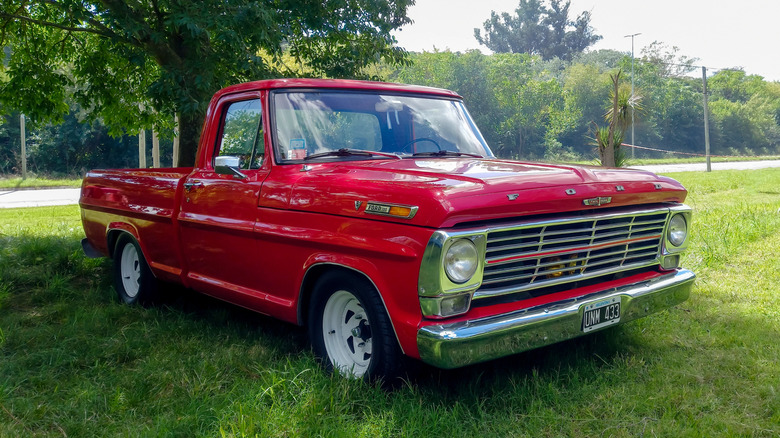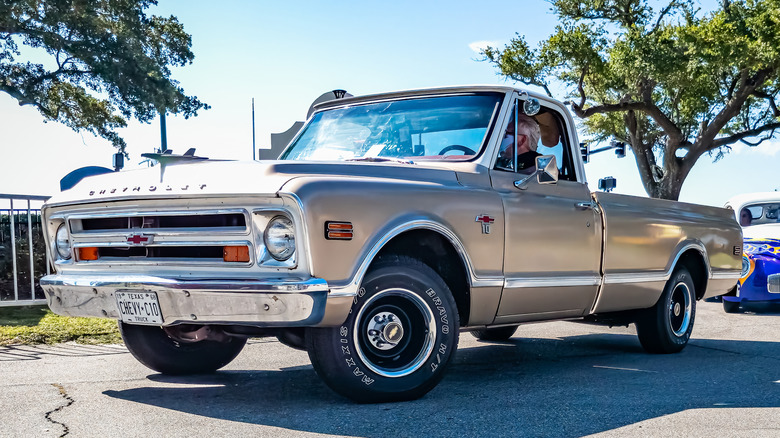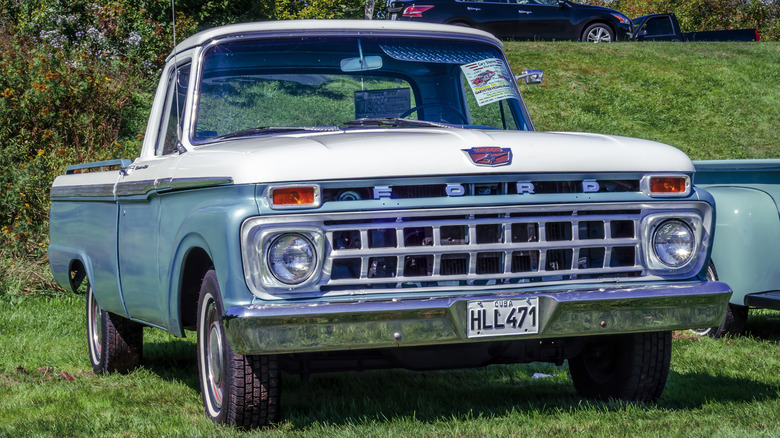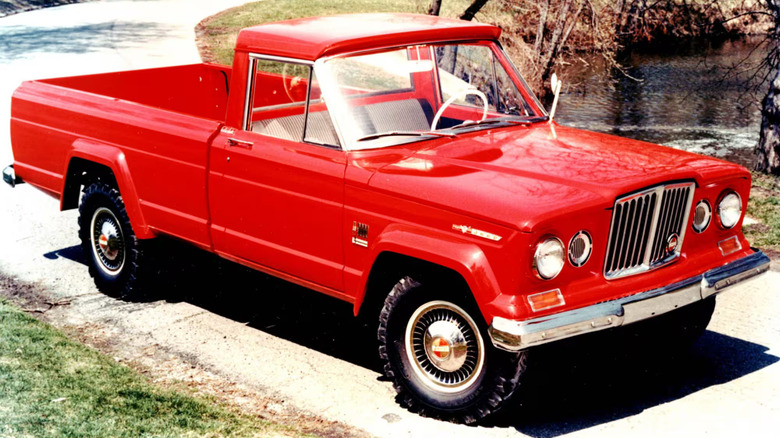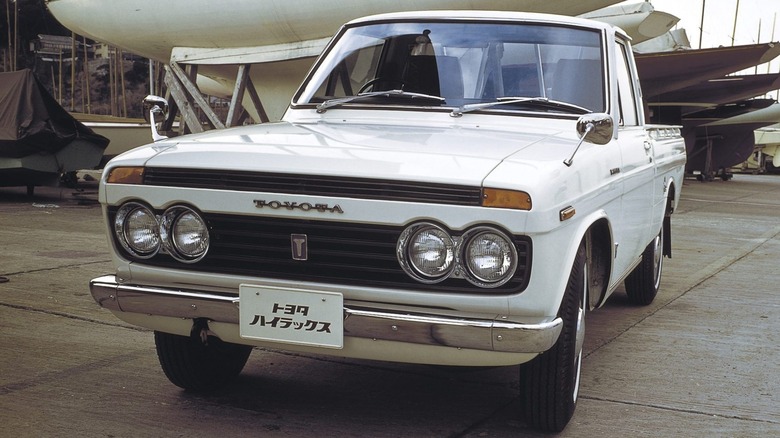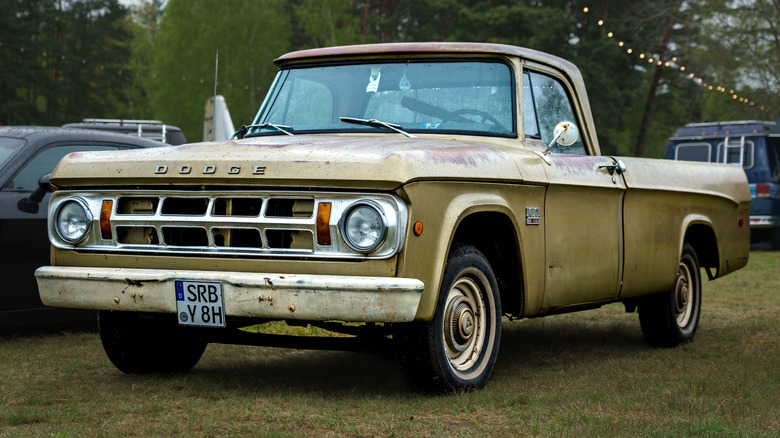5 Of The Best Pickup Trucks To Come Out Of The 1960s
Cars come in all shapes and sizes — hatchbacks, sedans, SUVs, MUVs, coupes, convertibles, and pickup trucks. and more — each serving its purpose. Among these, pickup trucks are so popular in the U.S. that they are a fixture of America's automotive landscape, serving as cultural icons and practical workhorses. The versatility of the pickup lies in delivering incredible power, a rugged nature, all-weather performance, and impressive towing capabilities. These features have earned the pickup a special place in the hearts of Americans. The Ford F-150 has been ruling the U.S. pickup truck market for the last four decades, and, according to Car and Driver, the top two best-selling vehicles of 2024 are none other than pickup trucks.
The world's first pickup truck –- the Ford Model T Runabout –- was introduced back in 1925 and sold for $281. This pickup truck was so appealing that Ford moved over 33,000 units in the first year of production. Over the period, pickup trucks have evolved into tougher and more capable machines as decades passed. By the 1960s, competition and market demand encouraged automakers to merge heavy-duty performance with the comfort and artistic styling of passenger cars. The result was trucks from the 1960s becoming highly collectible in the modern world. Here are five of the best pickup trucks of the 1960s that defined a generation and laid the foundation of modern-day pickup trucks.
Chevrolet C/K Series Second Generation (1967-72)
American automobile company Chevrolet has been manufacturing pickup trucks since 1918, with the first model being the Chevy Model 490 Light Delivery. The 1960s marked the beginning of one of its iconic models, the C/K Series pickup trucks. The 'C' in the C/K Series indicated two-wheel drive models, whereas the 'K' denoted four-wheel-drive options. The first-generation model came with an all-new frame, new suspension for a smooth ride, a dropped center frame that made it easier to get in and out of the truck, and introduced independent front suspension, which supplied the C/K Series with car-like handling.
The second-generation Chevrolet C/K Series pickup trucks built between 1967 and 1972 brought more innovation. Notably, the second-generation C/K Series was also called the 'Action Line' because not only did it include an upgraded suspension and chassis, but it also introduced luxurious interiors coupled with exteriors featuring modern design language. The second-generation Chevrolet C/K Series pickup trucks were also the first to debut coil-spring rear suspension, improving maneuverability.
The second-generation C/K Series was also offered in a variety of engine options, including inline-six and the powerful 327 ci V8 powerplants, and a 4x4 trim for heavy work. For those willing to spend extra money, Chevrolet offered luxury-focused Custom Sport Truck (CST) and Cheyenne trims that added lavish interiors, extra chrome, upgraded seats, and other cosmetic improvements.
Ford F-100 Fourth Generation (1961-66)
Ford is practically synonymous with pickup trucks, especially in the U.S. One of the oldest car makers in the world, Ford has produced the F-series pickup trucks since 1948, and is still going strong. The Ford F-series has remained an incredibly popular pickup truck, maintaining the title of best-selling pickup truck in the U.S. for the past 48 years. The Ford F-100 (known as the F-1 at that time) series pickup truck is one of the most iconic Ford models ever built, and the first generation debuted back in 1948. The pickup truck was Ford's response to the growing demand for family-oriented utility vehicles in the booming and industrious post-war era.
With the introduction of the second generation, Ford changed the nomenclature from F1 to F-100, rumored to be in honor of the U.S. Air Force's first supersonic fighter jet, the F-100 Super Sabre. Fast forward to 1961, and Ford introduced the fourth-generation F-100 with a unibody design that integrated the bed and cab, eliminating the gap between the two and offering more cargo space than previous models. This design made assembly much easier and less expensive to produce for Ford.
However, this unibody design was short-lived because it flexed a lot when carrying heavy loads, causing the doors to remain locked. This prompted Ford to discontinue the unibody design in 1964. The new model received changes such as a 1-inch higher roof, a new grille, and an all-new bed. With the 1965 model, Ford introduced twin-I-beam suspension with a slogan, "Drives like a car, works like a truck."
Jeep Gladiator J-Series (1963-87)
Jeep, which has been producing vehicles for over 80 years, was formed to help the American military transport things from one place to another, function as an ambulance, house machine guns, serve as a radio car, and do everything the army demands. Now part of the Stellantis group and with a host of legendary nameplates under its name, Jeep continues to produce some of the best off-roading vehicles for modern-day enthusiasts. However, the best pickup truck from Jeep to come out in the 1960s is the Jeep Gladiator J Series.
Jeep used the name Gladiator for its first full-size pickup trucks, introduced in 1963, sharing its platform, styling, and engine options with the Wagoneer. The Gladiator was available in two variants: the J-200 (120-inch wheelbase) and J-300 (126-inch wheelbase), with strong four-wheel drive parts such as Dana 44 axles and a Dana 20 transfer case. In 1965, Jeep changed the names, and the J-200 and J-300 came to be known as the J-2000 and J-3000, respectively, and were available in two- and four-wheel drive options.
The J-series trucks were offered with powertrains like the Jeep Hi-Torque 6 and the optional Vigilante V8. Jeep dropped the Gladiator name in 1971, switching to the J-Series until 1987. The Gladiator name returned in 2019, and its latest 2025 model is packed with all the latest features and technology in several trim options.
Toyota Hilux 1st Gen (1968-72)
Toyota began trickling its reliability down to the Hilux in March 1968, and it earned a reputation as the most reliable and indestructible pickup truck ever. Currently in its eighth generation, the Toyota Hilux has sold over 19 million units. Interestingly, the car was manufactured outside of Toyota, by Hino Motors, Ltd., in Japan. The first-generation model came equipped with a 1.5-liter engine. Fun fact: The name 'Hilux' is a portmanteau of two words: high and luxury.
While the first production model had a short wheelbase, just over a year later, in April 1969, Toyota introduced the Hilux with a long wheelbase model with a 2,250 mm-long bed. The first-generation Hilux had a payload capacity of 1,000 kg and was 1,850 mm long. In 1971, the Toyota Hilux with a 1.6-liter engine and 83 hp output was introduced. For North America, Toyota launched the Hilux with a very simple name, the 'Toyota Truck,' which was equipped with either a 1.9-liter or 2.0-liter R-series engine, and only the short-wheelbase version with a long bed was available.
While the first-generation may not be the best version of the Toyota Hilux, it paved the way for one of the most iconic pickup truck names — one that remains in production and is as popular as ever.
Dodge D series 2nd Gen (1965-71)
After the success of the Dodge C-Series pickup trucks — sometimes considered among the best-looking trucks of their time — Dodge introduced the all-new D-Series. This lineup featured a redesigned chassis, body, and engine compared to the C-Series. Dodge offered the D-Series pickup trucks in multiple powertrains, including inline-six or V8 engines. It was also available in different cargo and bed lengths, allowing customers to select the pickup truck as per their needs.
Interestingly, Dodge offered the D-Series trucks in Custom Sports Special trim that featured a 7-liter Wedge V8 engine (which was quite maintenance hungry), pumping 365 hp. The improved suspension helped the pickup truck handle all the power. Looking back, many consider this model an early performance pickup truck. The second-generation D-Series included the D100, D200, and D300, some of the most beloved trucks to come out of the 1960s. The D100 was the full-size pickup, good for everyday tasks. For heavy-duty tasks, the D200 and D300 were the ones to go for, as they were built with commercial use and construction work in mind.
Dodge gave six engine options along with four trim packages to choose from for the second-generation Dodge D-Series pickups. In mid-1965, Dodge restyled the D100, and it was made available in four and two-headlight options. The 383 V8 engine became the standard by 1967, and in 1968, the D100 again got style treatment and now featured an eight-hole front grille for a bolder appearance.
